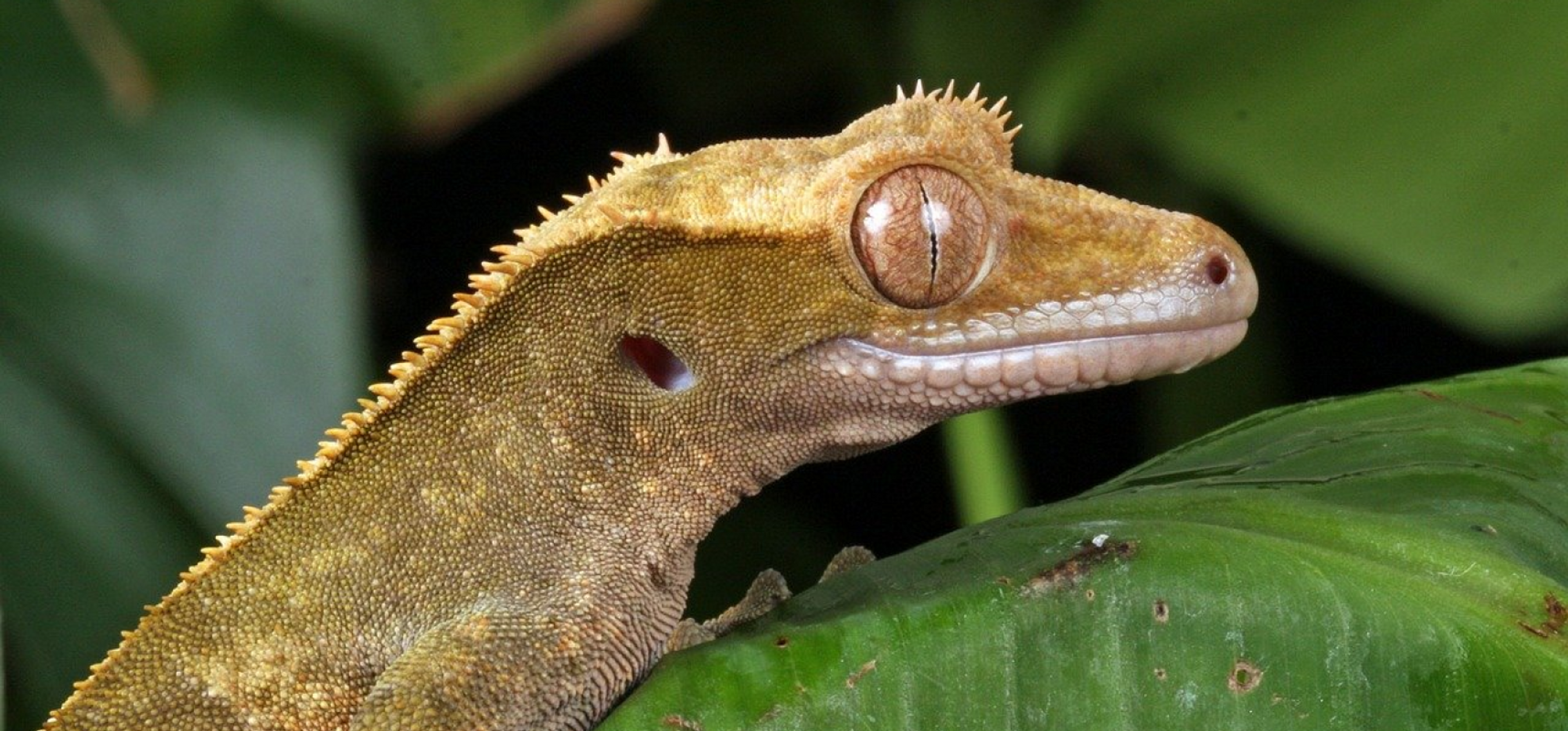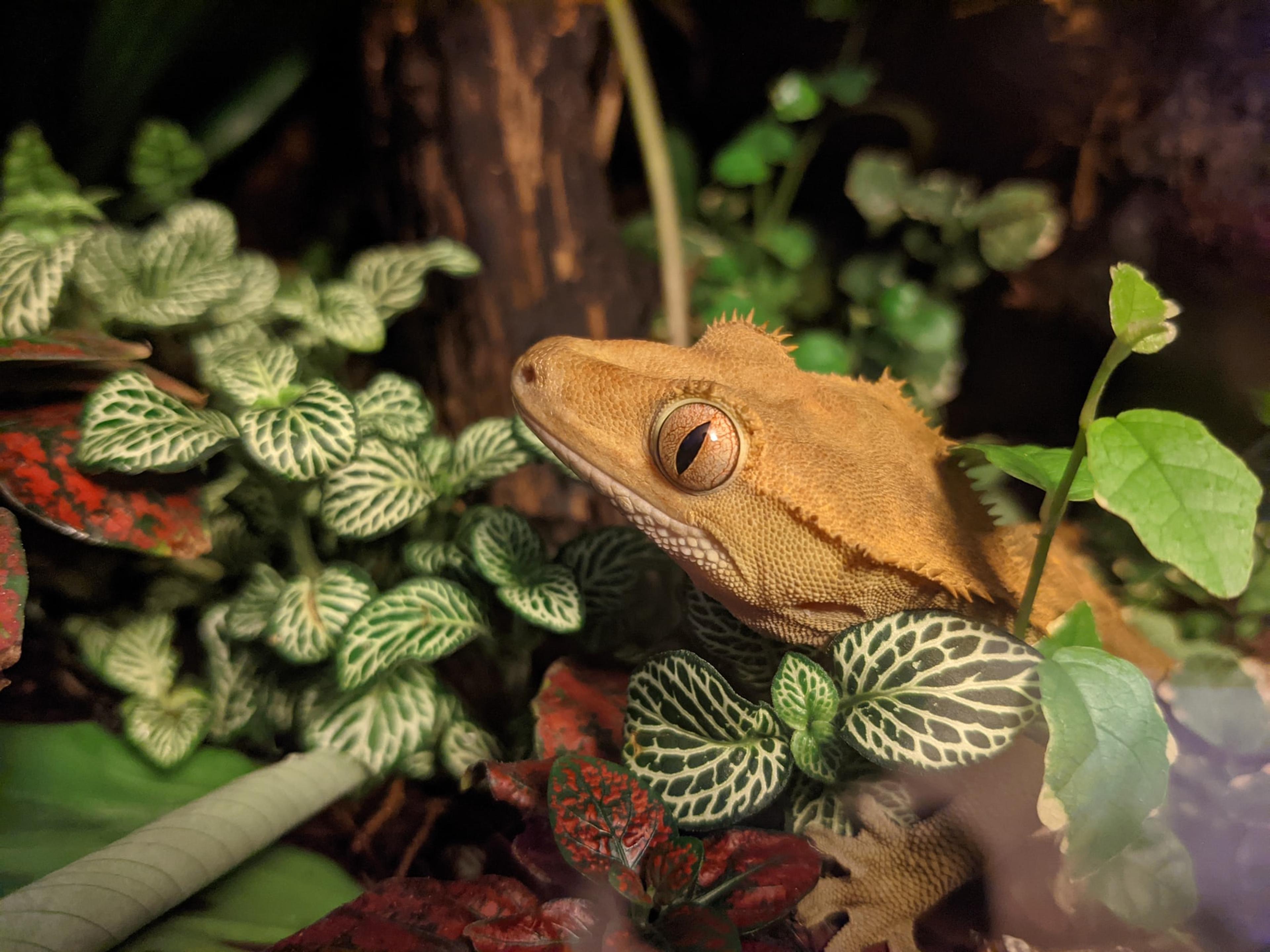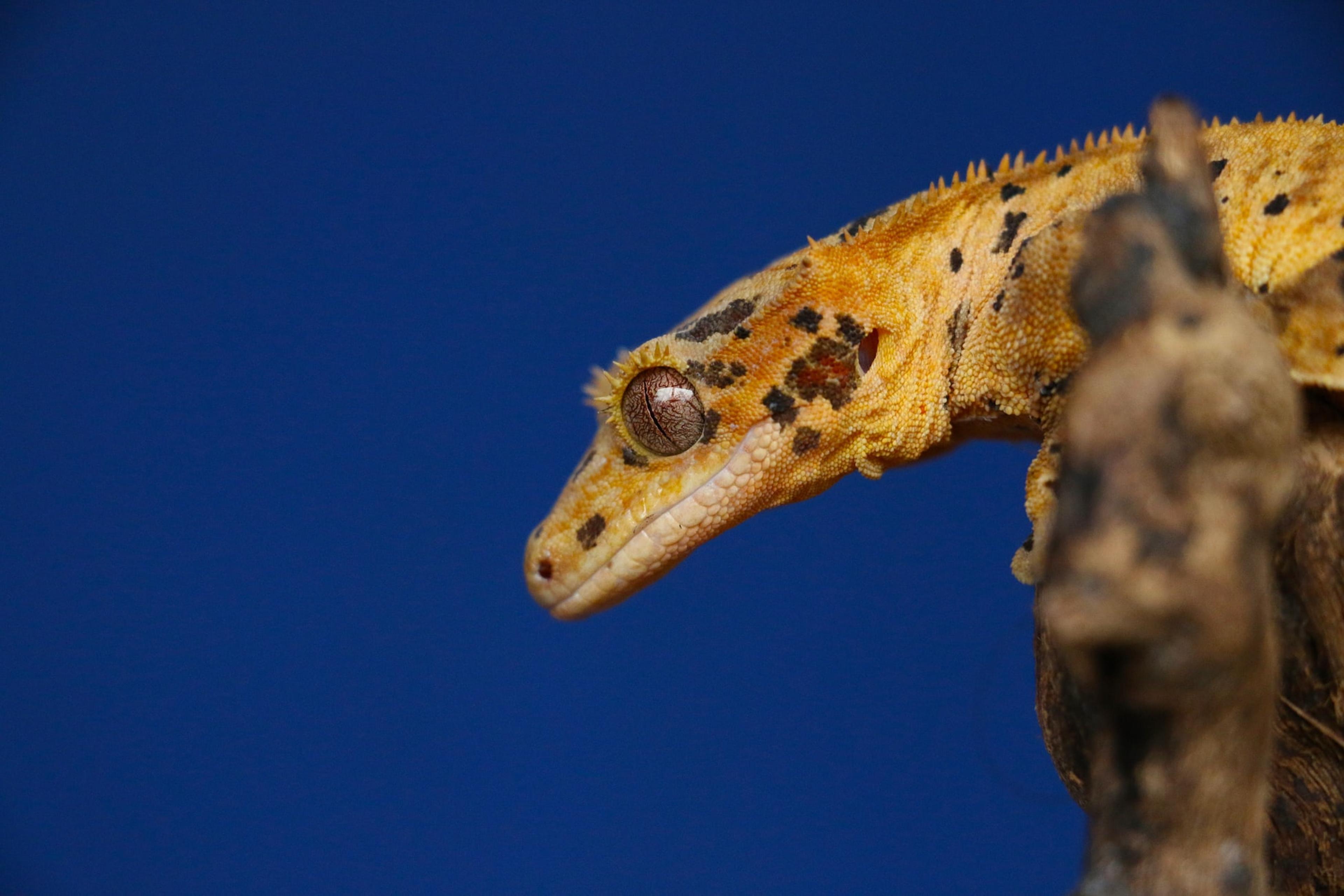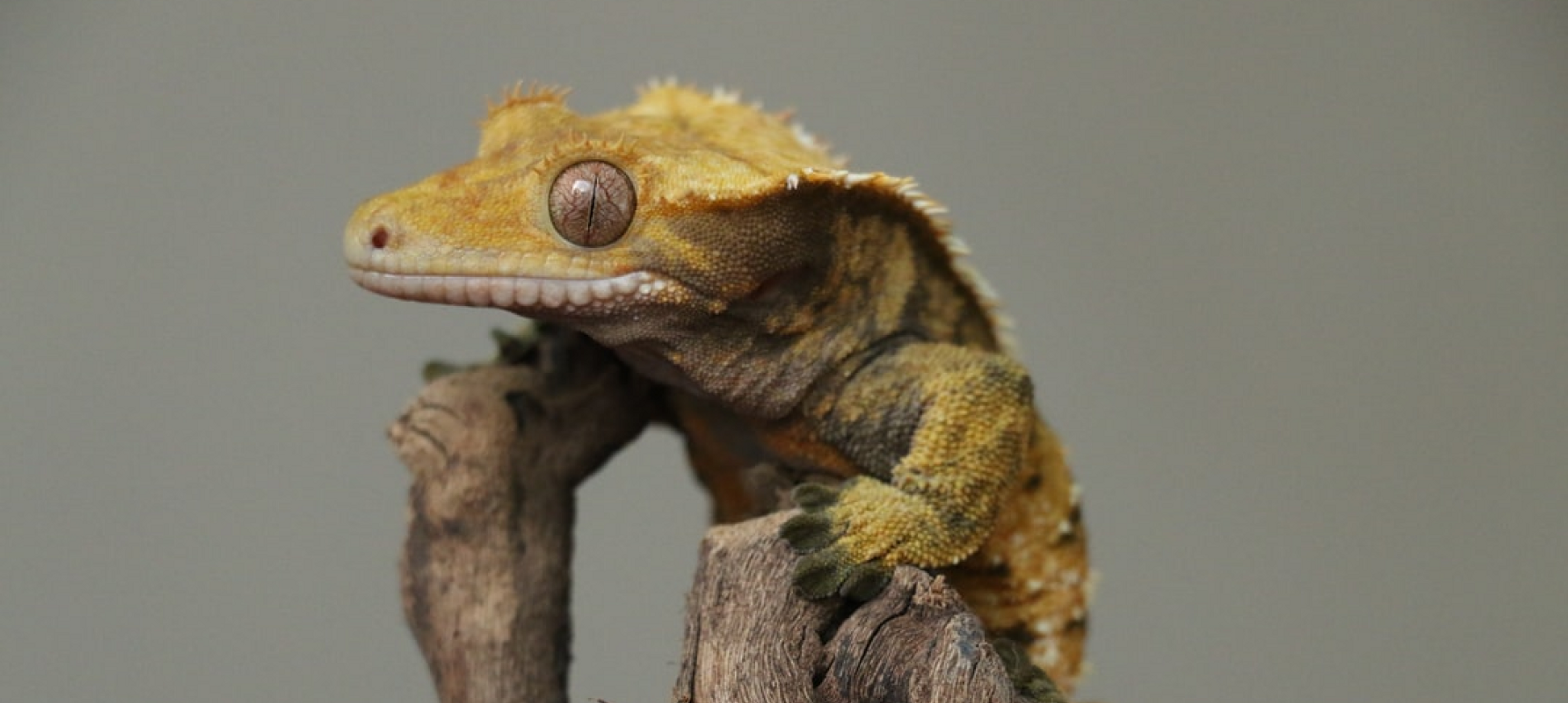What To Use Background Crested Gecko Cage
Crested Gecko Care Folio
Prepared by ReptiFiles
Crested geckos are a crepuscular (nigh agile at dawn and sunset), tree-abode species of gecko native to New Caledonia, a group of islands between Fiji and Australia. These geckos are omnivorous, eating fruits, nectar, and some insects. They usually mensurate about viii inches long from snout to tail and take an average lifespan of 15-20 years. Crested geckos exercise non have eyelids, are able to walk up smoothen, vertical surfaces, and can "fire up" when excited, making their colors more intense!

This Intendance Guide been curated by ReptiFiles .
ReptiFiles is an online database of comprehensive, scientific discipline-based reptile care guides created by reptile husbandry specialist Mariah Healey. ReptiFiles' chief goal is to promote a college standard of animal welfare within the reptile industry.
Read Full Care Guide
Crested Geckos at a Glance
Here are some cadre facts about crested gecko care:

Quick Facts

Size
6-8″

Active During
Dawn/Dusk

Lifespan
15-20+ years

Nutrition
Omnivorous

Humidity
High

Habitat
Arboreal

Basking Temp
82-85°F

UVB
Recommended

Availability
Common
Natural Habitat

Semi-Tropical Rainforests
Crested geckos are naturally found in New Caledonia.
Handleability Score
iv out of 5: Expert Handleability
Crested geckos are oft quite tolerant of humans and tin can be dandy to handle. However, they are commonly asleep during the day when humans are agile. Check out the instructions in our Taming & Handling section to learn more than almost how to properly interact with your crested gecko.
Care Difficulty
Beginner
Expected Weekly Dedication: 2 hours minimum
Crested geckos are sometimes recommended as a "first reptile" for children and adults alike. While they are relatively easy to care for, please annotation that even the easiest reptiles can be expensive and high-maintenance to keep, and children's pets should always be supervised past an developed.
Daily chores may include misting the enclosure, preparing nutrient, and spot-cleaning. Food and water dishes should be replaced or disinfected weekly, as well as any soiled surfaces.
The corporeality and frequency of spot-cleaning required will depend on whether your enclosure is bioactive or not. We'll cover these corresponding chores in the Enclosure Enrichment section.
What'south great:
- Readily available
- Handleable
- Small
- Piece of cake to feed
- Hardy
Things to be aware of:
- Non very active during the 24-hour interval
- High humidity
- Oestrus sensitive
- UVB strongly recommended
- Can drop its tail if stressed
Enclosure
Crested geckos need at to the lowest degree an 18″ x 18″ x 24″ enclosure, preferably larger.

Reptiles aren't like dogs and cats that tin can simply roam around your firm. They are very sensitive to their surround, and need their own enclosure gear up according to their specific needs. This guide covers everything you will need to intendance for your pet crested gecko properly.
Enclosure Size Requirements
Developed crested geckos should be housed in an enclosure that is no smaller than 18″L 10 xviii″W x 24″H. This is the bare minimum, calculated co-ordinate to the reptile's average length and activity patterns.
Nonetheless, if y'all can provide an enclosure with more floor space and height, do information technology! Housing your gecko in a larger enclosure will encourage it to be more active and demonstrate more than natural behaviors.
Grow-out enclosures
Although information technology's safe to keep a baby in an adult-sized enclosure, it can be stressful for new keepers to notice and feed their pocket-sized hatchling in a larger infinite. Young crested geckos are ofttimes housed in a series of smaller "abound-out" enclosures to better keep track of such a tiny gecko, make food more than easily accessible, and monitor their health during this vulnerable phase of life. These enclosures tin be standard terrariums or modified Sterilite bins/tubs with a mesh-covered pigsty in the lid for ventilation.
Although juveniles can be transferred directly to their adult enclosure afterward reaching almost 12g, you may wish to provide multiple feeding stations until your gecko grows and becomes fully accustomed to the environment.
If y'all have or are planning to proceed a young crested gecko in a smaller enclosure, there are some special accommodations you will need to make in terms of UVB and heating, which we volition cover in the Lighting and Heating sections. Abound-out enclosures should even so accept all the same required temperatures, humidity, and climbing/hiding enrichment every bit an adult enclosure, just on a smaller scale.

Tin can multiple crested geckos be housed in the same enclosure?
We do not endorse the cohabitation of crested geckos, since we believe that the risks far outweigh the declared benefits. Crested geckos are solitary by nature and practice non need "friends," they are perfectly content living alone. Some keepers still choose to house more one gecko per enclosure, and while we don't support this, those who choose to do and then should exist fully aware of the risks:
Injury/Health
Whenever you cohab a non-social species like crested geckos, you run a risk authority/territorial fighting and resources competition, which can result in high stress, malnourishment, injury, and expiry. Cohabited geckos are very likely to lose their tails and sustain other mild to severe injuries. If any tail nipping, crest biting, weight loss, or otherwise unusual behavior is observed, the geckos must be separated immediately! The but way to fully avoid these behaviors is by non cohabiting in the first place.
Gender compatibility
Male + male person = NEVER! Males WILL fight and injure or even kill one another.
Female + female = High risk of stress/injury, multiple females must "move in" at the same time be of similar size. Compatibility is not guaranteed.
Male person + female = Guaranteed stress/injury, must be kept under shut and constant supervision. Never cohab a male person and female person unless you're trying to breed, they WILL mate and lay eggs! The most responsible breeding practice is to only put them together for several days during convenance season, not year round. Y'all should not brood reptiles on a whim, information technology takes years of experience and grooming to breed safely and ethically.
Enclosure size
two geckos would demand a bare minimum of 36" 10 18" ten 36" terrarium. For each boosted gecko afterward that, another 5-10 gallons of infinite must be added. The more geckos sharing a space, the higher the risk of incompatibility and competition.
Crested Gecko Enclosure Examples
twenty"x20"x32" - Photo contributed by Alina East.
Substrate Options
Substrate is the material that you use to cover the floor of the enclosure. This aspect of the enclosure is important considering it contributes to overall humidity levels. For best results, crested geckos should have at least two-4″ of substrate. Information technology's a skillful thought to also have a drainage layer on the bottom, similar Zoo Med Hydroballs or The Bio Dude'southward Hydrogrow, to preclude the substrate from getting soaked and inhibit mold/bacterial growth.
The all-time substrate for crested geckos is a DIY mix of roughly 60% untreated topsoil + twoscore% coconut fiber (similar Eco World). Topsoil must not incorporate whatever fertilizers, manure, or perlite/vermiculite - read the ingredients! Mix well, soak until muddy, so pack it firmly on top of the drainage layer or at the bottom of the enclosure.
Y'all can too use a pre-packaged substrate, though this can be more plush than DIY. Hither are some recommended commercial substrates advisable for crested geckos:
Some other option is a bioactive enclosure. Bioactive setups are designed to mimic a reptile's natural environment and stimulate natural behaviors. DIY substrate, BioDude Terra Animal, and Reptisoil can support bioactivity with the addition of a "cleanup crew" of isopods and springtails that make clean up uneaten food, fallen leaves, and fecal remains, making bioactive substrates self-cleaning and incredibly low maintenance.
Nosotros recommend natural, loose substrates because they hold humidity better and are much more than attractive. However, if heating is non perfect, loose particles tin sometimes pose an impaction risk to geckos smaller than 13g. If you lot have a young crestie or just wish to skip the take a chance birthday, yous tin can use paper towels until you're comfy moving on to a natural substrate. Paper towels are also the platonic substrate for quarantine and "infant bins," merely must be spot-cleaned daily and replaced weekly.

Unsafe Substrates for Crested Geckos
These substrates are particularly dangerous to crested geckos because they pose major wellness risks. Avoid the following substrates at all costs and stick to the list in the previous section.
- Wood shavings, chips, or bawl - impaction chance
- Pine/fir/cedar - irritates eyes/lungs & tin can cause neurological damage
- Reptile carpet - harbors bacteria, can rip out teeth/claws & break toes
- 100% Coconut cobweb (Eco World, Plantation Soil) - expands in the stomach
- Shelf liner - produces dangerous VOCs (volatile organic compounds)
- Linoleum - produces dangerous VOCs (volatile organic compounds)

Quarantine Substrate
When you first bring your new crestie home, y'all volition need to quarantine for at least one calendar month. This means keeping the enclosure as sterile as possible and closely monitoring the fauna's health.
Paper towels are the all-time substrate for quarantine, as they can be oftentimes replaced and make information technology easier to observe carrion and other potential health bug. Paper towels should be fully replaced at least one time a week and any soiled areas must be replaced daily. Once your gecko has shown a clean pecker of health, y'all can introduce your long-term substrate to the enclosure. Juveniles can be kept on paper towel for the duration of their time in a "baby bin" while you lot prepare their eventual developed enclosure with a natural substrate.
If you lot already have other reptiles in your abode, yous should extend the quarantine menses to three months, continue the enclosure in a separate room if possible, and make certain not to share whatever tools or decor between your new gecko and other pets, unless fully sanitized between each use.
Environmental Enrichment
Reptiles are much more intelligent than we humans tend to give them credit for, and that means they need things to entertain them. Otherwise they exist in a state of perpetual boredom, which makes them boring, inactive, and overall less interesting equally pets. When reptiles take objects to interact with in their enclosure, they become less stressed and more engaged with their environment. This practise is called environmental enrichment.
Information technology's important to cull enrichment items (a.k.a. enclosure decor) that are appropriate to your pet'south natural behaviors. Here are some objects that serve a vital function in a crested gecko terrarium:
Climbing/Jumping Opportunities
Crested geckos are arboreal and dearest to bound, and so a vertical climbing scape is essential. Branches, vines, cork bark/tubes, bamboo, and alpine plants are all splendid options. They should be arranged throughout the enclosure at various angles (horizontal, diagonal, vertical), so the gecko tin can climb, jump, and balance at varying heights. Create at least one perch near the top of the enclosure that is fully exposed to the heat and UVB lamps for basking. The middle and lesser levels should accept plenty of shady areas to balance and hide.
If you collect any woods from outside, requite it a adept scrub and bake at 250°F for about an hour &/or soak in a disinfectant compatible with porous surfaces, such as Clean Break or F10SC.
Comprehend/Hides
Yous'll demand to provide enough of places for your crestie to hibernate and feel secure in its environment and to self-regulate UV, light, and heat exposure. Modest, cozy, suspended hides like coconuts or lofts tin be nestled amongst the branches or attached to the walls. Plants with bushy or big leaves are also a groovy way to provide comprehend and emulate their natural environment.
Water Accumulation
Plant leaves, moss, and a proper substrate volition help go on humidity levels in cheque, but choosing decor items that can accrue water on the surface is great for gecko hydration, also! Cresties love to lick droplets from leaves after mistings.
Plants
In addition to providing necessary cover and climbing, live or artificial plants make an attractive addition to any enclosure. Brand sure whatsoever alive plants are nontoxic and suited to a tropical environment and artificial plants are cleaned and sanitized them before calculation to the enclosure. Check out our listing of gecko-safe establish options here. If you lot have live plants, consider installing a 6500K daylight lamp to aid them grow and flourish.
Ledges
Flat ledges attached to the walls or sturdy branches can serve as resting spots, basking spots, and feeding stations. Special "cup-holder" ledges are great for food and water stations, more on those in the Feeding Guide section!
Background
Bated from helping your setup wait squeamish, a expert groundwork tin provide more than climbing opportunities and help your gecko feel more than secure if the terrarium is fabricated of drinking glass. A background should ideally comprehend three sides of the enclosure.

How do I keep my enclosure make clean?
To control the growth of pathogens and keep your crested gecko'southward enclosure hygienic and smell-free, information technology's important to clean it regularly.
Non-Bioactive Enclosures:
Spot-cleaning should be performed daily. This is the routine removal of uneaten food, feces, urates, and contaminated substrate. Food dishes should exist cleaned or replaced 2-3x a week. Soiled surfaces and water dishes should be scrubbed with reptile-safe disinfectant and rinsed at least weekly. Solid substrate must be replaced or sanitized monthly, while loose substrate should exist completely removed and replaced every 2-4 months, depending on how diligent you are about spot-cleaning. This is also a good time to completely clean the enclosure with an animal-safe disinfectant like F10SC or chlorhexidine.
Bioactive Enclosures:
If you lot have a bioactive enclosure, "cleaning" will exist more like periodic maintenance: watering the plants, adding biodegradables, and feeding the CUC equally needed. Substrate does not need to exist replaced. Some spot-cleaning will still be required for urates and soiled surfaces. Food and h2o dishes should nevertheless be replaced or disinfected weekly.
You may also demand to routinely remove h2o spots/mineral deposits from the drinking glass of the enclosure. 1 of the most efficient ways to remove these is past scraping them off with a razor blade.
Lighting
Crested geckos should have ii types of lamps in their enclosure: A oestrus lamp (required) and a UVB lamp (strongly recommended)

UVB is of import for healthy metabolism, specifically vitamin D synthesis and calcium metabolism, improving peel health, and strengthening the immune organization. Vitamin D3 can exist provided through fortified crested gecko diets and supplement powders, but relying on this method alone is less constructive and more hard to regulate, then nosotros strongly recommend using a proper UV lamp as well.
UVA is beneficial to eyesight and is sensed by their pineal gland to regulate a circadian rhythm. UVA is emitted past both UV lamps and halogen bulbs.
Infrared radiation (i.e. heat) is important for reptiles' thermoregulation. As ectotherms, they rely on the rut of the sun to warm their bodies and stimulate their metabolism, digest their nutrient, and stay alert and active. The shorter the wavelength, the deeper it can penetrate their muscle tissue. In captivity, we tin provide this with specific heat bulbs that emit the most beneficial infrared wavelengths (IR-A and IR-B).
All light and heat should be kept on a regular schedule using outlet timers or done manually. This allows for a predictable day/night cycle which the gecko tin follow, allowing for natural hormonal rhythms and good mental health. We recommend the following schedule for crested geckos, based on their natural environment:
UVB
Crested geckos do good greatly from a UVB lamp in the enclosure. In add-on to vitamin D3 synthesis, having a calorie-free in the enclosure helps regulate their day/night bike, which is practiced for mental health and stimulates appetite. This should be provided with a 2-7% UVB output T5 or a 5% UVB output T8 lamp, depending on your setup. We recommend Arcadia or Zoo Med brand linear fluorescent tubes, equally these are the best and most reliable UV lamps on the market.
The bulb should be ½ to ¾ the width of the enclosure in order to create an advisable vertical UV gradient. So if you have an eighteen″ terrarium, you'll need a 12″ linear bulb.
Best UVB bulbs for crested geckos:
T5 bulbs last 12 months, while T8 and meaty bulbs last 6 months before requiring replacement, as the UVB output decays over time. Off-make UVB bulbs are likely to have shorter lifespans and unreliable output. Avoid coil UVB bulbs, as these cannot properly distribute a UV slope throughout the enclosure.
Distance
The strength of the UVB lamp's output varies according to distance from the bulb - stronger when closer, and weaker when further abroad. If you are using a Solarmeter 6.5 to measure your UVB lamp's output, the UVI (UV Index) reading should be between 1.0-2.0 at the highest basking branch/surface and down to 0 at the lowest perch or substrate level.
If y'all don't take a Solarmeter, hither is a rough estimate of how far away your basking surface should exist, based on which bulb you are using:
All five-seven% lamps should exist mounted above the mesh.
Still, the Arboreal two.4% is designed specifically for New Caledonian geckos and should always be installed within the enclosure below the mesh, as per Arcadia's recommendation.
Fixture
To optimize your UVB bulb'south performance, you will need a high-quality reflective T8 or T5 HO fixture, depending on your bulb of choice. The Arcadia ShadeDwellers (linked above) come up in a kit that already includes a fixture. Otherwise, Zoo Med makes hood fixtures for T8 bulbs.
Hatchling/Juvenile Enclosure Lighting
If y'all have or are planning to keep a immature crested gecko in a grow-out enclosure, y'all will demand to make special accommodations for UVB. Hatchlings and juveniles should ideally have access to the aforementioned UVI range as adults, but abound-out enclosures are too small to achieve this without exposing the gecko to dangerously loftier levels of UV.
For this reason, it's common practice to avoid using UV lamps entirely for small-scale grow-out enclosures nether 18" in height. Raising geckos to 12g or and then without UVB is unlikely to cause long-term damage, from what nosotros've observed among breeders. One time the gecko is moved to a 12" x 12" x eighteen" or larger, UVB can be provided as per the guidelines in the to a higher place section. We recommend upgrading your gecko to a juvenile or developed-sized enclosure every bit soon as they reach almost 12g, so they can do good from UVB during crucial growth and developmental stages.
Heating
Crested geckos need access to a diverseness of temperatures within a certain range in society to properly regulate their metabolism:
- Basking area surface (top of enclosure): 82-85°F
- Cool area ambient (bottom of enclosure): 70-75°F
- Nighttime ambient (whole enclosure): 65-72°F
Ambient (air) temperatures should never stay higher than 86°F or lower than than 65°F! All heat lamps should be plugged into an outlet timer or a thermostat with a built-in timer and ready to the same schedule as the UVB and daylight lamps, allowing for a natural temperature drop and a healthy cyclic rhythm.

Heating Equipment
The best manner to create a proper basking surface area and rut gradient for your crested gecko is with a low-to-medium wattage dimmable heat lamp. The 2 best bulb options for crested geckos are:
Halogen Flood Heat Bulb (25-50w)
Halogen flood bulbs are particularly excellent because they produce lots of Infrared A and B, which are the same wavelengths of heat produced by the sun. These wavelengths penetrate deep into your gecko's body, providing a more than efficient course of heating and reducing the amount of time a crepuscular gecko needs to bask.
Deep Rut Projector (50w)
DHP'south produce lots of Infrared-B and a small amount of Infrared-A, making them the best culling to a halogen oestrus bulb. These bulbs practice not emit light, so they tin be safely used day or night. If your home regularly drops below 65°F or y'all just want a lightless heat source, a DHP is the way to go.
Choosing which seedling to utilise tin can be tricky, since wattage and altitude make up one's mind how much heat it will produce. A twoscore-50w bulb with a thermostat is usually groovy for cresties, simply some setups may work improve with a 25w. When in incertitude, become a higher wattage and use a dimmer or dimming thermostat to attain the perfect basking temperature.
Fixture
Once you take a heat bulb, you will need a lamp to put it in. Our favorite is Fluker's 5.v″ dimmable lamp, as the dimming feature enables you lot to dial down the bulb'southward heat output if it gets too warm. Any fixture you cull should have a ceramic socket to ensure that the bulb doesn't get too hot for the lamp (risking electrical fire). If you have a fixture with an on/off switch, we recommend pairing it with a dimming thermostat or a plug-in dimmer.
Thermostat
Cresties are sensitive to temperatures and can suffer heat stroke if the enclosure gets besides warm and they don't take access to cooler areas. All heat sources should be connected to a thermostat with the probe on the basking surface to ensure a safe and good for you temperature range. A proportional (dimming) thermostat, similar the Herpstat, is more efficient and convenient equally it does all the dimming work for you, although they can exist pricy. An on/off thermostat is the cheaper pick, but is best used with a dimmable lamp or plug-in dimmer then yous can more than precisely control the heat output and extend the lifespan of the bulb.
Hatchling/Juvenile Enclosure Heating
If y'all have or are planning to keep a young crested gecko in a abound-out enclosure, you will demand to make special accommodations for rut. Hatchlings and juveniles should ideally accept access to the same temperature gradient as adults, but grow-out enclosures are often besides small to achieve this with the same equipment.
An 8″ x 8″ x 12″ hatchling enclosure does non have enough room on top for a lamp. To provide your gecko with a supplementary estrus source, attach a pocket-size, iv-five″ oestrus mat to one outer wall of the enclosure. The mat must be connected to a thermostat and set between 82-84°F. Place the thermostat probe between the heat mat and the glass/plastic of the wall to brand sure your gecko is not exposed to temperatures any higher than 85°F. Plow the heat mat off at nighttime, using the same day/night schedule you would for a lamp. While not every bit ideal as overhead heat, a mat is the safest option to bring up ambient temperatures and provide a slight gradient in such a small area.
A 12″ x 12″ x 18″ juvenile enclosure can use the aforementioned overhead heat lamp equally an adult enclosure. You may take more luck with a 25w bulb, but this will vary depending on private setups. Just make sure to connect your lamp to a thermostat, as ever, and prepare it to the proper basking temperature.

Dangerous Estrus Sources
These estrus sources are particularly dangerous to crested geckos because they tin can pose major health risks and cause stress. Avoid the following oestrus sources at all costs and stick to the bulbs we recommend above.
❌ Colored bulbs
Red, blue, purple, and other colored low-cal bulbs are inappropriate for near all reptiles. They can wash out your gecko'southward vision and brand it harder to role ordinarily. In fact, blue lights are known to potentially damage reptiles' eyes!
❌ "Nighttime" bulbs
The idea that reptiles can't see scarlet, purple, or "blackness" light is a myth! They may non be able to see the colour, merely they tin can yet see the light. Using any lights at night tin can interfere with your gecko's day/night cycle, causing stress and poor health.
❌ Mercury vapor bulbs
Mercury vapor bulbs and other heat+UVB combination bulbs (Zoo Med PowerSun, Exo Terra Solar Glo) are overpowered and dangerous for crested geckos, who need a low-heat, low-UVB environment to thrive. These bulbs can't be used with thermostats and tin hands fire your gecko, and then it'southward much safer to provide and control your heat and UVB separately.
❌ Heat rocks
Estrus rocks (also known as hot rocks/stone heaters/etc.) are notoriously unreliable and many a reptile has lost its life due to severe burns caused past these devices. They're also not a good choice for heating your enclosure, as it only warms the stone'southward surface, not the surrounding air.
Measuring Temperature
To ensure proper temperatures in your crested gecko enclosure, you will need good thermometers. Temp gun-fashion infrared thermometers are useful for measuring surface temperatures anywhere in the enclosure. However, digital probe thermometers are useful for being able to track local air temperatures at a glance. It's best to have at to the lowest degree 2 thermometers to measure temps on each end of the vertical estrus gradient. Here are some devices we recommend for measuring temperatures:
Humidity
Crested geckos thrive within a range of lx-lxxx% boilerplate humidity. Y'all should mist ane-3 times daily as needed, depending on local climate/weather. Make certain to let the enclosure dry out to effectually 40-50% before misting again - constant moisture encourages mold and mildew growth, which can make your gecko sick.
The goal of each misting is to encompass the found leaves and sides of the terrarium with water droplets, stopping before the soil becomes overly saturated. Don't mist the enclosure again until all water droplets have evaporated and the top almost layer of the substrate has started to dry. Proper ventilation must exist present in the enclosure to allow this humidity regulation process.
Because cresties potable these misting aerosol, do not use distilled or softened water! Tap, spring, and fifty-fifty filtered h2o (assuming that it'due south rubber for humans to drink) contains minerals vital to your gecko'south health. Yous can dechlorinate tap water with a conditioner similar ReptiSafe.
Achieving proper humidity levels can be as like shooting fish in a barrel and inexpensive equally a hand mister or as complex as an automated misting organisation - Not to be dislocated with a fogger, which doesn't create the necessary h2o droplets. Misting systems, similar the MistKing, can be regulated precisely with a timer or even a humidity regulator. The Herpstat2 is a great option because the 2 outlets are controlled separately, meaning you lot tin regulate both estrus and humidity with a single unit.
Y'all can measure humidity with a hygrometer like the Zoo Med Digital Combo Gauge linked in the Measuring Temperature section. These are the other products we recommend for misting your crestie enclosure:
Feeding Guide
Crested geckos are omnivores, both frugivorous (fruit eating) and insectivorous (insect eating). They exercise best when fed an appropriate commercial nutrition, supplemented by feeder insects.

It's best to feed your crested gecko primarily with a high-quality commercial crested gecko nutrition, plus alive insects. Crested gecko nutrition (CGD) is a nutritionally-complete powder that becomes a repast replacement smoothie when water is added.
Here is a bones feeding schedule for your pet crested gecko:
The key to a healthy, balanced diet is variety, so make sure to provide as many different kinds of foods in your crested gecko's diet as possible!
CGD Options:
- Pangea
- Repashy
- Arcadia
- Lugarti
- Black Panther Zoological
- Gecko Pro
- Leapin' Leachie
- Zoo Med
Insect Options:
- Crickets
- Dubia roaches
- Red runner roaches
- Black soldier wing larvae
- Silkworms
- Darkling beetles
- Snails (preserved)
- Grasshoppers
- Small hornworms
How to feed your crested gecko
Crested Gecko Diet
Mix 1 serving of powdered CGD with h2o to a ketchup or smoothie like consistency and offering in a small-scale biodegradable or reusable loving cup. Near cresties prefer eating high above the ground, so y'all'll need a wall-mounted feeding ledge.
Crested gecko diets come in many flavors, and every gecko tends to have favorites (and least favorites)! They oft prefer the diets that their breeders used, only this can definitely change, so it's great to offer a diverseness of flavors and brands to a new gecko. Notice what your crestie likes the most and stick to information technology!
Insects
Offer about 1-2 appropriately-sized bugs per inch of your gecko's length. Some feeders may require more or less per meal. Take intendance non to offer anything too big—while worms have soft bodies that are easy to chew and digest, roaches, beetles, and crickets should be no wider than the infinite between the gecko's eyes. Avert mealworms and superworms for crested geckos. These are high in chitin, making them hard to digest, leading to impaction in some cases.
Ever offer live insects. Expressionless or canned insects don't trigger your gecko's "hunting mode," and so they most likely won't get eaten. Make sure to gutload your insects with fresh veggies at least 12 hours earlier feeding.
All feeders should be convict bred. Don't feed your gecko bugs from your lawn — these can make your pet sick! Here are some sites we recommend to buy safe, captive bred feeders:
- DubiaRoaches.com (variety of feeders)
- PremiumCrickets (variety of feeders)
- Luna Roaches (discoid roaches simply)
- Beastmode Silks (silkworms only)
Calcium and Vitamin Supplements
Crested gecko diet is already fortified and balanced with a diverseness of vitamins and minerals. However, feeder insects still need to be lightly dusted with a calcium supplement pulverization to residual out the calcium-to-phosphorus ratio in their bugs.
If you take a UVB lamp in your crested gecko enclosure, Arcadia CalciumPro Mg and Miner-All Outdoor are both solid calcium options for cresties. For best results, use as directed by the label.
If you don't provide UVB, yous'll need a calcium powder with added vitamin D3, like Repashy SuperCal HyD, but nosotros strongly recommend using UVB for all reptiles!
Keeping Your Gecko Hydrated
Contrary to pop belief, crested geckos can drink water from a bowl. Almost feeding ledges have space for 2 additive cups, then provide CGD in ane and fresh water in the other. Your gecko volition still drink after yous mist the enclosure, just if they become thirsty betwixt mistings, they won't take to await!
Practice not use distilled or softened water. Tap, bound, and even filtered water (bold that it'southward safety for humans to drink) contains minerals vital to your gecko'southward health. You can dechlorinate tap water with a conditioner similar ReptiSafe.
Taming & Treatment
Crested geckos can be swell to handle when properly tamed. However, it'southward still of import to respect their boundaries and build a trusting relationship with your pet. This requires lots of patience and consistency, but is very rewarding in the end.

DO:
- Wait at least two weeks for the gecko to settle in earlier handling
- Permit it get used to your presence
- Scoop it upwards from beneath
- Use ho-hum movements.
- Handle your gecko over a soft surface like a bed or couch
- "Treadmill" information technology from hand to manus if it's beingness jumpy
- Wash your easily before and after handling
DON'T:
- Start handling your gecko as shortly as you bring information technology home
- Grab information technology from higher up
- Take hold of its tail
- Allow children handle the gecko without supervision
Expect 2 weeks later bringing your gecko home before handling. Kickoff with v minute sessions every few days. It seems brusque, merely it gives your gecko fourth dimension to recover and realize that you aren't a predator. In one case your gecko is consistently at-home during handling, you lot tin can gradually extend the handling sessions to 15 minutes at most. Do not handle your gecko more than once a day, preferably no more 4 times a week.
When you get-go treatment your gecko, do it over a soft surface similar a bed or couch. Cresties are known to take "leaps of faith" where they bound without a detail target for landing.
Go along in mind that all geckos have individual personalities! Some may be more tolerant of treatment than others - make sure y'all respect their boundaries to avert unnecessary stress.
Health Conditions
Hither are some common health problems to look out for:

The most mutual diseases in crested geckos are Floppy Tail Syndrome (FTS) and Metabolic Os Illness (MBD). They tin likewise suffer from health bug such as dehydration, obesity, impaction, and tail loss. If your gecko is displaying potential symptoms of disease, it'due south important to accept them to an experienced reptile veterinarian right away for diagnosis and treatment. Do not try to care for them at dwelling house, as you could make the trouble worse!
Signs of a healthy crested gecko:
- Articulate optics
- Direct spine and limbs
- Breathing with mouth airtight
- Regular bowel movements
- Eats regularly
- Moves freely and easily
- Alert
Signs of an unhealthy crested gecko:
- Excessive weight gain
- Rapid weight loss
- Deformity
- Animate with oral fissure open
- Appetite loss
- Diarrhea or constipation
What To Use Background Crested Gecko Cage,
Source: https://www.happydragons.com/reptiles/crested-gecko/care-guide
Posted by: kelleynobster.blogspot.com


0 Response to "What To Use Background Crested Gecko Cage"
Post a Comment